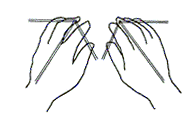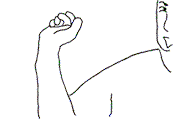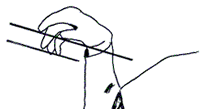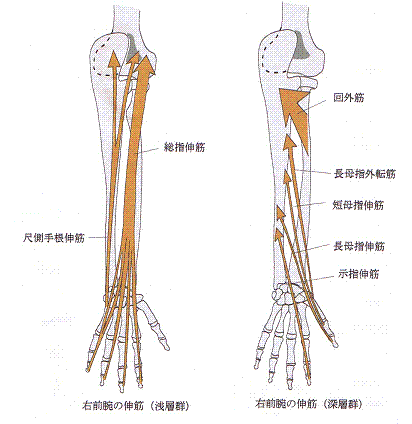3. A review of the position of the
fingertips while typing
I focused on the three-dimensional positions of the fingertips of the key operator.
╯The three-dimensional positions of the tips of the middle,
third, and little fingers
Place your hands on the surface of the keyboard in a natural manner. You will find that the surface of the back of the hand is inclined, as explained before; and when you look at your fingertips carefully, you will also find that the tips of the middle, third, and little fingers come in contact with the horizontal plane of the key surface naturally.
 The fingertips of the middle, third, and little fingers are situated on
the horizontal plane due to a balance between the inclination of the back
of the hand and the relative lengths of these fingers (Point 1). The fingertips of the middle, third, and little fingers are situated on
the horizontal plane due to a balance between the inclination of the back
of the hand and the relative lengths of these fingers (Point 1).
 The two lines which are made by connecting the fingertip points (middle finger ◥ third finger ◥ little finger, and middle finger ◥ index finger ◥ thumb) and the central axis of the forearm forms an ﹍arrow﹎. The arrow is formed whenever the fingers are stretched or bent. The two lines which are made by connecting the fingertip points (middle finger ◥ third finger ◥ little finger, and middle finger ◥ index finger ◥ thumb) and the central axis of the forearm forms an ﹍arrow﹎. The arrow is formed whenever the fingers are stretched or bent.

Now, when you place your hands on the surface of the keyboard in a natural
manner (axes of right/left forearm are turned upside down in a V shape),
you will discover an additional fact, i.e. the ﹍blades﹎ of the middle,
third, and little fingers coincide with the key line
(Point 2).
If the ﹍blade﹎ does not coincide with the key line, please adjust the angle of the two ﹍axes﹎ of the ﹍arrows﹎; then the right/left hand blade will be on a single straight line.
╯The three-dimensional positions of the tips of the index
finger and thumb
Let us attempt an anatomy experiment.
 Bend an elbow keeping your arm close to your side, and bend your wrist, as you would stand to throw a baseball. Then throw a baseball; however, your elbow should be bent and close to your side. Bend an elbow keeping your arm close to your side, and bend your wrist, as you would stand to throw a baseball. Then throw a baseball; however, your elbow should be bent and close to your side.
 If you look at your fingers, you will find that the knuckle of the index finger is more stretched as compared with the knuckles of the middle, third, and little fingers, and you will also find that the thumb does not hang downward. If you look at your fingers, you will find that the knuckle of the index finger is more stretched as compared with the knuckles of the middle, third, and little fingers, and you will also find that the thumb does not hang downward.
The four fingers, excluding the thumb, have a muscle called the extensor digitorum, the function of which is to stretch the knuckle on the side of the back of the hand. Both edges of this extensor digitorum are located at the bone of each fingertip and at the bone of the upper arm (between the shoulder and elbow).
When bending a wrist on the side of the palm, an extensor digitorum tenses and pulls the knuckle.
Moreover, the index finger and thumb have a peculiar muscle each, i.e. the ﹍index finger extensor﹎ and ﹍thumb extensor,﹎ respectively, in addition to the extensor digitorum.
Both edges of these peculiar muscles are located at the bone of each fingertip and at the bone of the forearm.

(Tosiho Terashima, Department of brain science developmental neurobiology
Graduate school of medicine, Kobe University
Kobe University digital library, "Lecture note of anatomy")
Therefore, while bending a wrist on the side of the palm, the index finger
is doubly pulled, and its knuckles become more stretched as compared with
those of the middle, third, and little fingers. The thumb is kept its independent
(horizontal) positoin by the thumb extensor.
In conclusion, we can state that the tips of the index finger and thumb
are ﹍floated﹎ over the key surface when the hands are placed over the
keyboard in a natural manner (Point 3).
|